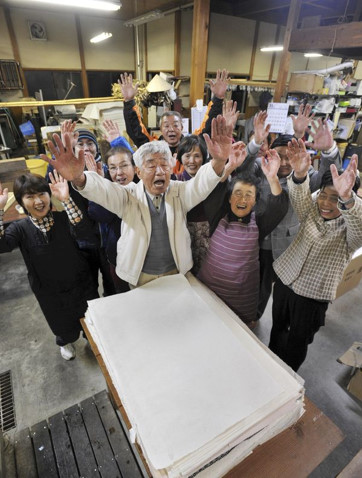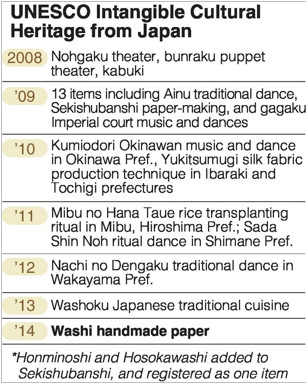http://the-japan-news.com/news/article/0001750455
Posted on The Japan News by The Yomiuri Shimbun on November 27, 2014
Teizo Takano, a chairman of an association of Hosokawashi craftsmen,
and other related people give a banzai cheer at a paper studio in Higashichichibu, Saitama Prefecture, on Thursday.
By Mina Mitsui / Yomiuri Shimbun CorrespondentPARIS
— UNESCO decided Wednesday to designate Japanese traditional techniques for making washi paper as an intangible cultural heritage.
At a meeting of its intergovernmental committee in Paris, UNESCO said the craftsmanship is passed from generation to generation in families and local communities as a cultural symbol of the residents in certain areas and strengthens social ties. The decision follows last year’s recognition of washoku traditional Japanese cuisine, indicating high international regard for Japanese traditional culture.
The registered products are Sekishubanshi from Hamada, Shimane Prefecture; Honminoshi from Mino, Gifu Prefecture; and Hosokawashi from Ogawa and Higashichichibu, both in Saitama Prefecture.
All 24 nations represented on the intergovernmental committee approved the recommendation by a UNESCO subsidiary body last month to add washi to the list. The committee appreciated the tradition of washi, stating that local people are proud of the tradition and are planning such preservation activities as skill training and hands-on lessons at schools.
Japan has so far been awarded 22 intangible cultural heritage registrations, including washoku, kabuki, noh and Yukitsumugi silk fabric production techniques. The latest registration does not change the total number of Japan’s heritage listings as Sekishubanshi was already designated as an intangible culture heritage in 2009. Its heritage status will be registered again with the two other washi products.
The government tried to have Honminoshi added to the heritage list by itself in 2011, but the intergovernmental committee deferred a decision that year, saying the paper product is similar to Sekishubanshi. The government therefore changed its plan to aim at the overall registration of the three products, adding Hosokawashi as a new candidate. In Japan, they are designated as important intangible cultural heritage and preservation groups exist. The government submitted a proposal to UNESCO in March last year.
The Yomiuri Shimbun:
The government emphasized the paper-making traditional techniques, which date back to the eighth century, explaining the unique process in which paper is made from kozo mulberry pulp, and paper solution is uniformly spread on a hinged mold called sugeta.
Source: The Japan Times by The Yomiuri Shimbun
http://the-japan-news.com/news/article/0001750455


